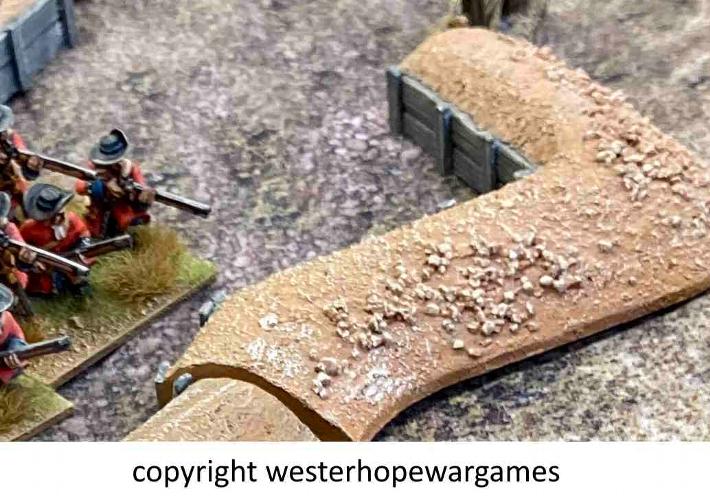Tangier Environs
Although St Catherine's Port with its fort-like gateway, dramatic ravelin and ditch and the city walls are photogenic, they don't play much of a part in the fighting around Tangier. More useful are palisades, caltrops, covered ways, rivers and rolling hills with one reconfigurable fort. Later battles would require the addition of trenches, a few cannon and, ideally, city walls and Moors' tents.
In the first phase of the occupation Ghailan's forces had no cannon with which to attack forts or fortifications and so most of the early confrontations took place in the open countryside. Palisades and pikes were often sufficient deterrent against free-riding horsemen with muskets and lances and cavalry support could flush out concealed skirmishers. Nonetheless successive governors thought cavalry too expensive and unnecessary - hot-headed officers rushed into pursuit without bothering to ensure cavalry support - and often paid the price.
Later conflict often took place around the small forts as the Sultans, with greater resources than Ghailan, determined to attack with siege equipment or destroy them with shot from one or two captured cannon (often commanded by Europeans who accepted circumcision and converted to Islam rather than face life as slaves).
In the later stages, during the Siege of Tangier, forts were besieged by trenches (a table-top example - which requires no excavation - is given above), undermined and assaulted with cannon-fire.
Almost every fort was of a different design - rock was quarried as needed - and once again a set of reconfigurable sections of wall would be best suited.
In the final battles during September and October of 1680 the Moors had some captured cannon and large numbers of regular troops, and had reduced most of the outlying forts. The English garrison had been greatly reinforced, and were commanded by a more capable Governor. Battles took place relatively close to the city walls around the forts and hills that presented the greatest threat to Tangier itself at that time.
Table-top Scenery
I used green faux fur for the meadow-land outside Tangier, placing suitable objects underneath for the hills, trees that were a good match for boxwood, a river made by a modeller, and a 3D printed bridge modified from one I bought online. Distant hills were represented by a moorland model railway background.
For reference works I would suggest:
‘Tangier – the Earliest Battle Honour' Pen & Sword – John Hawkins (me). This narrative history (i.e. true history in the form of a novel) is as accurate as I could make it, being largely researched from primary sources. It has a comprehensive index and contains maps of Tangier and its defensive forts at various times, and of several major battles. The text contains dramatized descriptions of armies, uniforms and tactics.
‘The English Garrison of Tangier' Helion - Andre Abram. This, as its title suggests, concentrates on the facts and figures of the garrison. As far as I can tell it is accurate, but much of it is not in chronological order and lacks an index, so it can be quite time consuming trying to discover specific facts.
‘Tangier1662-80' Leonaur – various authors. An unedited collection of writings, all but ten or so pages devoted to the year 1680. Best used for obtaining several points of view on the battles of the Siege of Tangier.
‘The Tangier Campaign' Tempus – A J Smithers. Written in a very casual style, with many inaccuracies and misleading statements, I would not recommend this to anyone wanting a reasonably accurate view of English Tangier.

